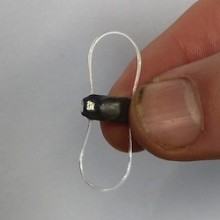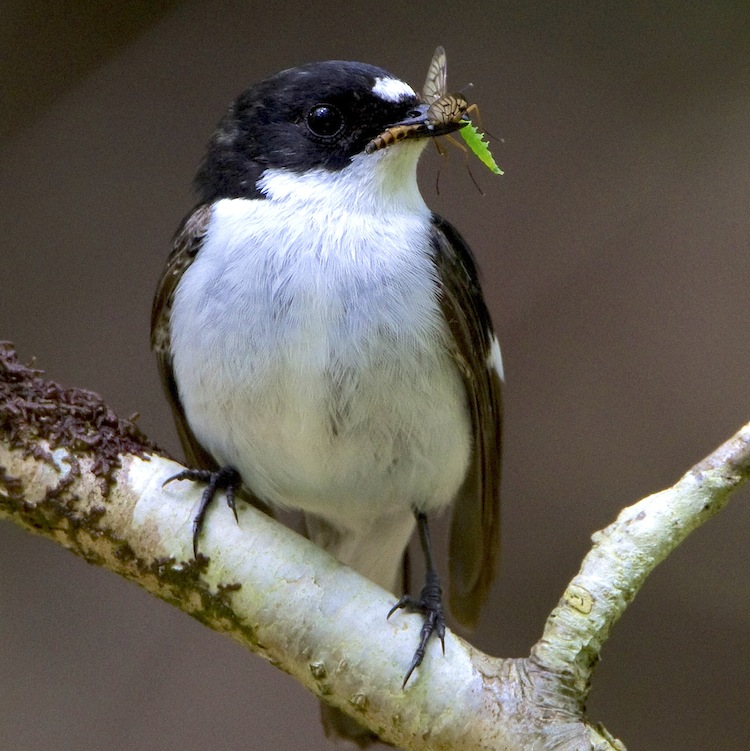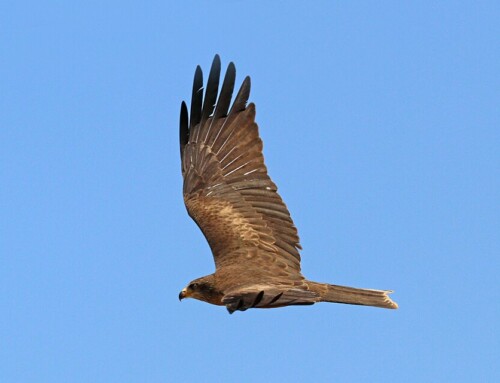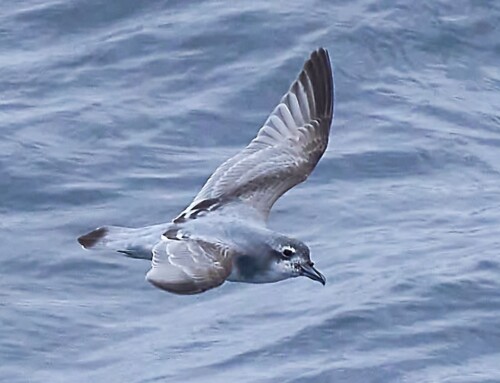LINKED PAPER
Light-level geolocators reveal migratory connectivity in European populations of pied flycatchers Ficedula hypoleuca. Ouwehand, J., Ahola, M. P., Ausems, A. N. M. A., Bridge, E. S., Burgess, M., Hahn, S., Hewson, C., Klaassen, R. H. G., Laaksonen, T., Lampe, H. M., Velmala, W. & Both, C. 2015. Journal of Avian Biology. DOI: 10.1111/jav.00721
Pied Flycatchers Ficedula hypoleuca are one of the best studied passerines in Europe, yet we know little about their migratory timings or even where populations winter. We are now starting to find out.
Pied Flycatchers, like Blue Tits Cyanistes caeruleus and Great Tits Parus major, breed in nest boxes at high densities which enables large numbers to be monitored, so making them good model systems for all manner of studies. But an important difference between tits and flycatchers is that flycatchers migrate. Despite knowing a huge amount about Pied Flycatcher breeding ecology, we actually know little about their migration timings, migration routes or the locations of their African non-breeding grounds. This is important to find out, as the UK population has declined by 53% since 1995 (Baillie et al. 2014) and has declined in other parts of their European breeding range (BirdLife International 2015).
In the UK there is little evidence that declines are strongly linked to factors affecting them on their breeding grounds. Availability and quality of western oakwoods is largely unchanged (Amar et al. 2010), although it is possible that timing of breeding has become increasingly mismatched with prey availability as warmer and advanced springs result in earlier availability of invertebrate food (see my previous BOU blogs here and here). Such a phenological mismatch has been linked to European Pied Flycatcher declines (Both et al. 2006) although UK data suggests some adaptation, with advances in egg laying date at the same time as relatively unchanged productivity (Baillie et al. 2014). Although these factors may play some role, it seem likely that other important pinch points exist outside of the breeding season.
We know so little about the non-breeding and migratory ecology of Pied Flycatchers partly because we have been unable to follow individuals. Without any precise information about where they go between breeding seasons we have little to go on. In the UK, 645,000 Pied Flycatchers have been ringed since 1909, and yet just five UK breeding (and no UK hatched) have subsequently been found in African wintering grounds. This is one recovery per 129,000 birds; ringing alone is not going to help us. But continued miniaturisation of the lightest available tracking devises, geolocators, now means we are able to track Pied Flycatchers.

In 2012 myself and Chris Hewson (BTO) fitted geolocators to 20 adult male Pied Flycatchers at my long term monitored population at East Dartmoor National Nature Reserve in Devon, UK (Burgess 2014). This transpired to be an unlucky choice of year. The following spring was the coldest since 1962 with winter-like conditions continuing into April resulting in the latest Pied Flycatcher first arrival date at the study site for 23 years (despite a long term trend for earlier arrival). It was an extra nervous wait for tagged birds to return. But once they did arrive we quickly identified two birds, caught them and removed their loggers. The late and cold spring meant return rates were low for both tagged and untagged males and so we retrieved fewer loggers than we hoped. But the two tags we did retrieve revealed tracks and timings to Africa and back, and the two winter locations derived from 20 loggers is equivalent to 35 years of national effort ringing hundreds of thousands of individuals.
Just one track from a species can be newsworthy and provide totally new information, such as recent work on Red-necked Phalarope Phalaropus lobatus (Smith et al. 2014 – see their BOU blog post) and Ring ouzel Turdus torquatus (Sim et al. in press). Our two UK breeding Pied Flycatchers went to the same region as the UK ring recoveries – Liberia or southeast Guinea. This is important information, suggesting UK birds are concentrated in a relatively small portion of the species’ winter distribution in sub-Saharan western Africa.

University of Groningen PhD student Janne Ouwehand combined our UK data with equivalent data collected from other breeding populations from the Netherlands, Finland and Norway, which has recently been published in the Journal of Avian Biology (Ouwehand et al. 2015). This reveals an interesting pattern of migration connectivity. Instead of African wintering ranges being stacked west to east in order of breeding latitude, the opposite was found. This pattern was evident in both the geolocation and ring recovery data. Flycatchers from all populations shared a similar autumn migration route through Iberia and the western edge of the Sahara. But the timings were different, reflecting population differences in the mean timing of breeding. The earlier breeding UK and Dutch flycatchers departed their breeding grounds first (in mid-August). These flycatchers arrived in the humid sub-Saharan zone of western Africa first and then moved east until settling in an area encompassing Liberia/Guinea/Ivory Coast. The later breeding Fennoscandia flycatchers departed breeding grounds later, arrived in sub-Saharan Africa later, but remained in the western part of the humid zone instead of continuing eastwards. The geolocator data showed this was reversed in spring, with UK and Dutch birds departing from wintering grounds first and arriving back to breeding grounds earliest.
The work of Ouwehand et al. suggests the differences in wintering locations, and unexpected pattern of migratory connectivity, results from geographical variation in breeding phenology and timing of migration. From a conservation perspective this highlights a need for more study of seasonal food availability in wintering areas and how this affects migration ecology and fitness. This work contributes to the growing literature and debate on migratory connectivity (Cresswell 2014), which tracking studies are well placed to contribute to, especially through pan-population analysis of tracking data – another recent example being a pan-European study of European Rollers Coracias garrulus (Finch et al. 2015).
We waited for further miniaturisation of geolocators before tagging more UK flycatchers, but this season we tagged a further 20 adult males using geolocators 39% lighter than those used in 2012. We eagerly await some of these birds back next spring and hope in the future to look at individual repeatability and relate tracks to demographic information.
References
Amar, A., Smith, K. W., Butler, S., Lindsell, J., Hewson, C., Fuller, R. & Charman, E. 2010. Recent patterns of change in vegetation structure and tree composition of British broadleaved woodland: evidence from large-scale surveys. Forestry 83: 345-356.
Baillie, S. R., Marchant, J., Leech, D. I., Massimino, D., Sullivan, M., Eglington, S. M., Barimore, C., Dadam, D., Downie, I., Harris, S., Kew, A., Newson, S. E., Noble, D. G., Risely, K. & Robinson, R. A. 2014. BirdTrends 2014: trends in numbers, breeding success and survival for UK breeding birds. BTO Research Report 662. BTO, Thetford. View
BirdLife International. 2015. Species factsheet: Ficedula hyploeuca. View
Both, C., Bouwhuis, S., Lessells, C. M. & Visser, M. E. 2006. Climate change and population declines in a long-distance migratory bird. Nature 441: 81-83.
Burgess, M. D. 2014. Restoring abandoned coppice for birds: Few effects of conservation management on occupancy, fecundity and productivity of hole nesting birds. Forest Ecology and Management 330: 205-217.
Cresswell, W. 2014. Migratory connectivity of Palaearctic–African migratory birds and their responses to environmental change: the serial residency hypothesis. Ibis 156: 493-510.
Finch, T., Saunders, P., Avilés, J. M., Bermejo, A., Catry, I., de la Puente, J., Emmenegger, T., Mardega, I., Mayet, P., Parejo, D., Račinskis, E., Rodríguez-Ruiz, J., Sackl, P., Schwartz, T., Tiefenbach, M., Valera, F., Hewson, C., Franco, A. & Butler, S. J. 2015. A pan-European, multipopulation assessment of migratory connectivity in a near-threatened migrant bird. Diversity and Distributions. DOI: 10.1111/ddi.12345. View
Ouwehand, J., Ahola, M. P., Ausems, A. N. M. A., Bridge, E. S., Burgess, M., Hahn, S., Hewson, C., Klaassen, R. H. G., Laaksonen, T., Lampe, H. M., Velmala, W. & Both, C. 2015. Light-level geolocators reveal migratory connectivity in European populations of pied flycatchers Ficedula hypoleuca. Journal of Avian Biology. DOI: 10.1111/jav.00721.
Sim, I. M., Green, M., Rebecca, G. W. & Burgess, M. D. in press. Geolocators reveal new insights into Ring Ouzel Turdus torquatus migration routes and non-breeding areas. Bird Study. DOI: 10.1080/00063657.2015.1077779.
Smith, M., Bolton, M., Okill, D. J., Summers, R. W., Ellis, P., Liechti, F. & Wilson, J. D. 2014. Geolocator tagging reveals Pacific migration of Red-necked Phalarope Phalaropus lobatus breeding in Scotland. Ibis 156: 870-873.
Image credits
Top: male Pied Flycatcher © Tom Wallis
Bottom: Malcolm Burgess in the field © Andy Hay, www.rspb-images.com





